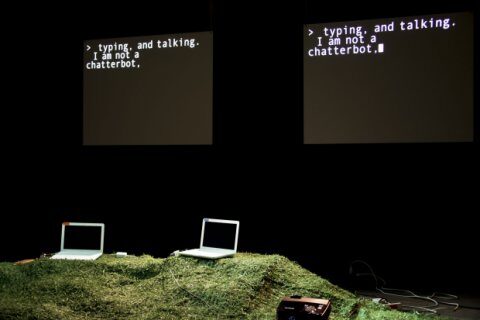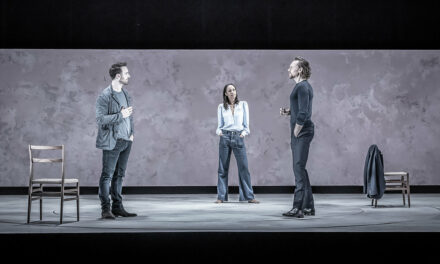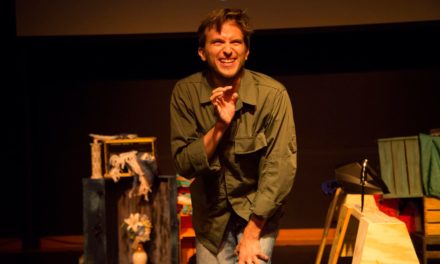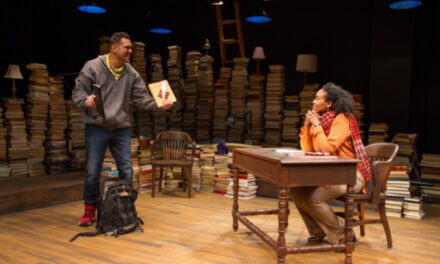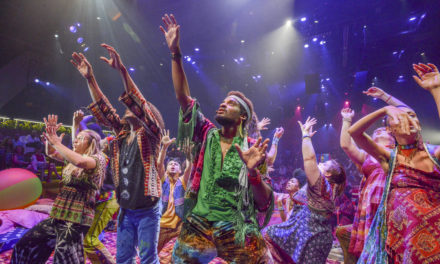What is algorithmic theatre?
For the last several years, I’ve been using the term “algorithmic theatre” to describe my projects. It’s a phrase I chose for two reasons. First, I wanted to distinguish what I was doing from “multimedia performance,” which describes work that uses video or other digital technology to open up alternate spaces for representation, or as a means to generate stage design or other effects. Second, and more importantly, I wanted to place my work within the lineage of algorithmic composition and algorithmic visual art.
Those early pioneers of computer art (Manfred Mohr, Vera Molnar, Roman Verostko, Harold Cohen, and others) chose the term for similar reasons: to distinguish the work they were doing in which they designed and wrote their own algorithms, from the larger field of computer art, which tended to employ ‘off the shelf’ software. The difference is significant. As Verostko writes, “Every graphics package uses algorithms and there is no computer generated art which is not “algorithmic.” So artists, whether they write their own code or not, already enjoy a great deal of the power of the algorithm coupled to a computer.”[1] He goes on to argue, however, that using commercially-available software does not allow for the investigations into the relationship between procedure and form that characterize the work of the algorists. Likewise, performance work that uses pre-existing software tends to make use of the effects that can be produced by computer technology, without incorporating the algorithm into the structural or ground-floor level of the performance.
I have written elsewhere about what I view as algorithmic theatre’s potential in relation to some fundamental principles of dramaturgy, theatre history, and theory. In that earlier writing I addressed topics within the theatre field, using the terms and arguments familiar to theatre practitioners and scholars. I name-checked Aristotle, Shakespeare, Artaud, Brecht, Jan Kott, and Peggy Phelan.
But recently I have been approaching similar issues from another entry point than the discourse common to theatre.
Not long after I began this work, I did a study of the artist Manfred Mohr, one of that early generation of algorists that includes Verostko. I took an interest in him not only for his artistic work but also for his writing, in which he lays out with great clarity many of the issues I’ve faced working with computers as artistic collaborators. It seemed likely that, since I was at such an early stage of developing how to work with algorithms in theatre, I could learn a lot from the corresponding early stage of the development of algorithmic visual art.
I read Mohr not only to see what I can apply from his experiments, but equally to see what I cannot apply – what doesn’t fit, what can’t be made to fit – and by this non-compatibility, to learn something about my larger project of developing a theoretical and practical approach to algorithmic dramaturgy.
Mohr began as an abstract expressionist, making formalist, two-dimensional works on paper, usually in black and white. He started to work with computers in the late 1960s after he was introduced to the composer Pierre Barbaud. In 1969 he made his first computer drawings, and in 1971 had the world’s first solo exhibit of computer-generated art at Musée d’art Moderne de la Ville de Paris.
Mohr’s own description of the algorithm: “A random walk of 100 alternating horizontal and vertical lines within an enclosed space is shown. The horizontal lines have a high percentage of a thicker width. The two drawings above show a continuous path, where lines change direction when they hit an edge of the space.”
“The elements are horizontal, vertical, 45-degree lines, square waves, zig-zags, and have probabilities for line widths and lengths. The algorithm places elements in a horizontal direction and has a high probability to move from left to right and a limited probability to backtrack. Thus an abstract text is created.” [2]
These works are notable for a few features:
Simplicity – they have a small set of basic elements and the combination of those elements is the action of the algorithm
A corollary to simplicity: you can guess the rules from looking at them
These are highly accessible works: if you would see one or two more examples of each set, you would easily be able to reverse engineer the generative procedure.
They are multiple – they are meant to be seen in groups.
And indeed, these are the features (along with one other) that Mohr himself made most note of in his artist statement from the exhibit.
Composition
But to begin with, he first writes about an analysis he made of his own earlier hand-drawn works – to try to understand his system, to discover consistent properties, techniques, compositional constants – and then describes how he went about incorporating the algorithms as creative partners. By this, he means not simply teaching the computer how to re-make prior works – but teaching it the underlying principles, developing “a vocabulary which integrates the computer into the aesthetic system.”[3] The emphasis is not on automating the work, but on making a new collaboration, with a new partner, operating with another logic.
He identifies 4 initial principles:
“Computer graphics, in general, are conditioned by four basic premises:
1. A precise idea of an aesthetical problem.
2. The need to break this idea into parts which could be reassembled as a program.
3. A steady control of the computing process to take full advantage of the Machine-Human dialogue.
4. The need for the logic of the events to become perceptible.”
He also writes about the value of such work: that it allows one to explore fully the complete set of possibilities that emerge from a given set of rules. Mohr writes, “…as it is possible (for a human) to conceive the logic of a construction but not all its consequences, it is nearly an imperative to rely on a computer to show this large variety of possibilities…which may lead to different and perhaps more interesting answers, lying of course outside of normal behavior but not outside of the imposed logic.” Which is to say, computers can generate ALL the possible iterations of a given construction, and almost of necessity will generate iterations that a human artist would discard or never encounter. The inclusion of all possible outcomes allows for an expansion of compositional possibilities, and of value and aesthetic judgments.
In this way, one learns to avoid the judgement of ‘good’ or ‘bad’ results. Mohr calls these “Wertfreie (value-neutral) procedures,” in which, “after a period of tests, modifications of the logic, and parameter exchanges, all possible results of a program have to be rigorously accepted as final answers.”
Finally, he writes:
“The concentration which is necessary to establish a logic – (writing a program – that means to give a definition of all instructions that have to done in the machine) – will reflect itself in the result as a clear construction which could be understood by everybody and there will be less and less (sic) mystical barriers behind which the artist can hide himself.”
He views the rationalization of art-making as a populist move – and rejects non-programmatic art as obscure, cloudy and mysterious. His mathematically-driven works are accessible to all, clear-cut and comprehensible. Here he inverts the usual formulation, the common-sense understanding that computer science and mathematics are difficult or overly-complex, and that “art that everybody can understand” is about self-expression and the personal inspiration of the artist.
So here we come to what truly interested me in Mohr’s text: all of these very reasonable and even sort of obvious principles of computer art are extremely difficult to deal with in the theatre. Taken one by one:
1. To make a proper analysis of one’s analog work – in the theatre – is not so easy. The whole construction of theatre is so damn complicated – between the actors, their physicality, their voices, the text, representations of time, place, action, the lighting scheme and other visual elements, sonic elements, architecture of the theatre building or performance space, etc, etc. It’s not merely a question, as it was for Mohr, of noticing certain two-dimensional compositional habits or repetitions. In fact, the further I have gotten in trying to ‘teach’ a computer how to make theatre, the more I realize that I don’t know what theatre is.
2. It’s also rather difficult to break a theatre process into parts. If one is dealing with a script, as I did with A Piece of Work, for example, one runs into all the usual sorts of natural language programming problems – double meanings, metaphors, idioms, frequent exceptions to all possible rules, emotion-bearing language, and so on. Further, one has to account for the textual conventions proper to theatre: stage directions, evocations of time and place, subtext, action, the “voice” of character. Taken together, these constitute the interpretive aspects of the form that tie it to psychology, literature, history, sociology. And then, when one is NOT dealing with a pre-existing play-script, the problems only get more difficult.
I quickly discovered while trying to “teach a computer how to make theatre” that the form relies intensely on all sorts of instantly recognizable human behaviors, not only for the audience but also for the interpretive artists who realize the play. (This aspect is, of course, one of the pleasures of doing a play, for those who do find pleasure there: an encounter between one’s own understanding of human behavior and that of a playwright.) Aristotle described “recognition” as the structural turning point of drama, the moment in the plot at which secrets are revealed and the underlying truth of the enacted situation stops everyone dead in their tracks. But “recognition” seems to me to be a much deeper element of theatrical performance than that: even in the most non-narrative, post-dramatic performance, the communication between audience and performer relies on the mutual recognition of readable human action.
3. Two points on the question of multiples. Naturally, in time-based performance, the audience sees only one version of the work. We on the creative team get to see a range of iterations – we get to know the state space of the program, as it were. But the audience sees it only once. One could, of course, include repetition within one evening’s performance, by, say, creating a shorter complete work which one would then do twice or three or twelve times in a row. I’ve chosen not to do that, for reasons I’ll address later in this essay.
4. The question of multiples is also closely related to the question of making the underlying logic of the system perceptible. Confronted with several iterations of the program, one can start to see the rule-set underneath; when you see only one, it’s impossible to know how what you are seeing was made. This has been a frequent discussion amongst my collaborators for each piece I’ve made. We debated, and at times vigorously disagreed about, whether to construct, for example, a pedagogic section for the piece that would have made the procedures clear, or some sort of visualization that illustrates the working of the algorithm. I have chosen not to include that either.
It may seem perverse to avoid including those constructions that might have allowed me to address the stipulations that Mohr describes, and in so doing make the work more transparent.
But I found myself bumping against another fundamental element of theatre that demanded attention, which has to do with the kind of ontological value I want to give the work. Presenting multiples would directly oppose another old Aristotelian concept, the so-called “unity of action.” It seemed important to be able to say: this is it. This is the event. The unity of action to my mind is not merely an old-fashioned historical point of interest – introduced by the Greeks, fetishized by the neoclassicists, rejected by the moderns. Nor is it only pertinent when dealing with narrative theatre.
The singularity of the event makes possible the paradox that is central to theatre: that it is always both real and not-real, it takes place here and now, but relies for its power upon its association to somewhere and sometime else. The performers stand in front of you, in a strange sort of presence – regardless of performance technique, even the most quotidian style of performance brings the performer into heightened otherness–, the time of the events onstage laid over the real time of the performance, the space of the stage always available to evocations of other spaces.
So including pedagogic material began to seem less and less pertinent, and it began to seem more imperative to make possible that the viewer should experience, if only briefly if only intermittently, some portion of that paradox which is essential to theatre and which distinguishes it from other forms.
To put it another way, theatre (as opposed to other time-based forms) has an inextricable connection to metaphor. This-here is always (potentially) that-there.
Metaphor
Since a part of my thesis is that algorithms can reinvent theatre (and that this work poses challenges not encountered when working with algorithms in the creation of other art forms), I thought I’d try out a few thoughts I’ve had about theatre and metaphor. It’s my tentative assertion that it is the metaphoric compulsion which makes theatre theatre, which distinguishes it from dance, from music, from performance art – it’s the metaphoric aspect of theatre which gives it that funny smell. And further, that the metaphoric compulsion is the essence of the theatrical paradox I described above.
I’m using the term “metaphor” here in the sense that the cognitive linguist George Lakoff uses it, which he describes in his essay “A Contemporary Theory of Metaphor.” Lakoff shows that metaphor is an everyday experience, not a poetic technique or a linguistic “special case.” Metaphor is rather a fixed conceptual mapping, which precedes any particular activation of it (i.e. in speech or image). A conceptual mapping ties concepts together, firmly and forever. Conceptual maps are culturally and historically specific, though some are so common as to approach universality.
As Lakoff notes: “It is important to recall that metaphorical mappings are fixed correspondences that can be activated, rather than algorithmic processes that take inputs and give outputs.”
By this he means that our human brains do not begin with a literal meaning and arrive at the metaphoric meaning through a transformational procedure – there is no search process, no translation process, no process of any kind. The mapping comes before any particular image or statement that may arrive to call it forth.
So if the theatre is a kind of machine that relies in its very essence on metaphor, on this-is-that (while paradoxically always also remaining merely this), then algorithmic theatre combines two incompatible modes of meaning-making by putting into play a “real-time, sequential” process that continually activates the underlying and fixed metaphors of our cognition.
The continuous presence of this type of performance bumps up against both the “stability” of the metaphoric ground of theatre and the relentless procedural action of the algorithm.
This train of thought was both cause and effect of my recent piece Yesterday Tomorrow, a project which began with an almost banal metaphor about the passage of time borrowed from sentimental pop songs. As the process unfolded, the piece allowed for a deeper investigation into the intimacies and contradictions amongst various models of time movement: the algorithmic, the digital, the theatrical, the melodic. And further, into the possibilities for productive cooperation between human and machinic logics.
[1] http://www.verostko.com/alg-isea94.html
[2] Both descriptions are taken from Mohr’s website, www. emohr.com
[3] From “Manfred Mohr Computer Graphics,” 1971, p.38
This post originally appeared on Etcetera on August 8, 2017 and has been reposted with permission.
This post was written by the author in their personal capacity.The opinions expressed in this article are the author’s own and do not reflect the view of The Theatre Times, their staff or collaborators.

